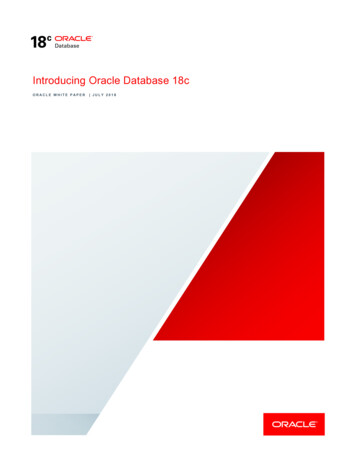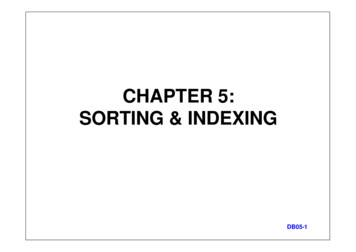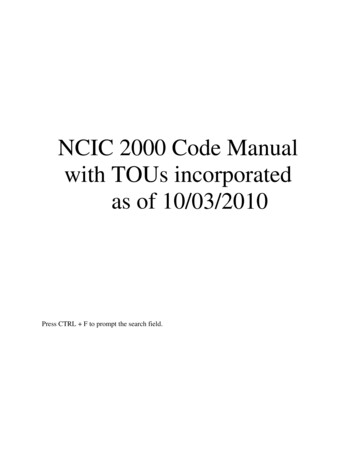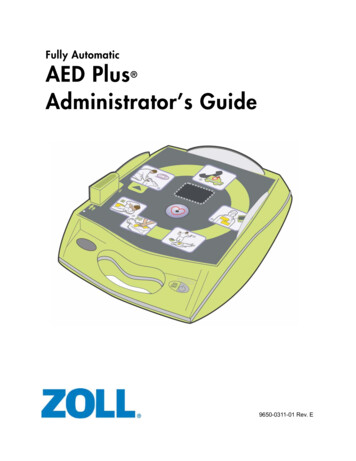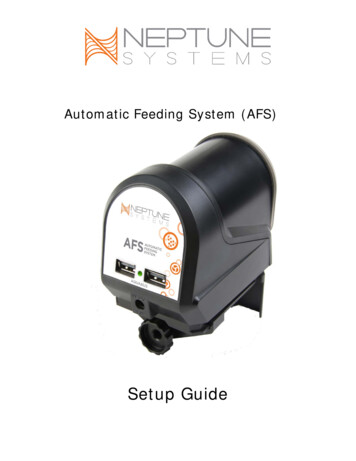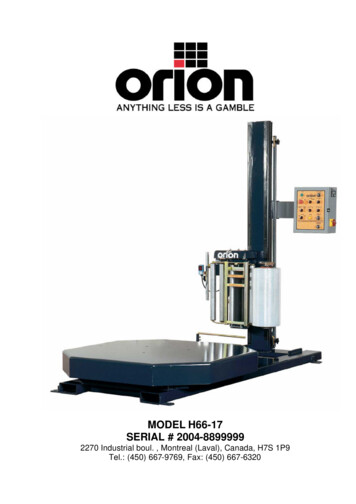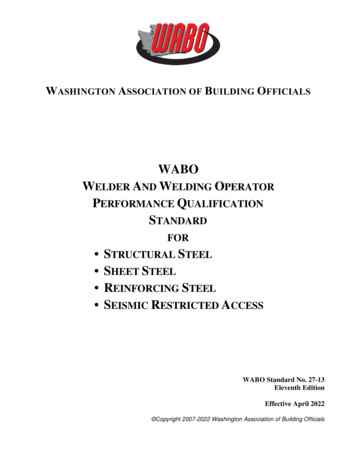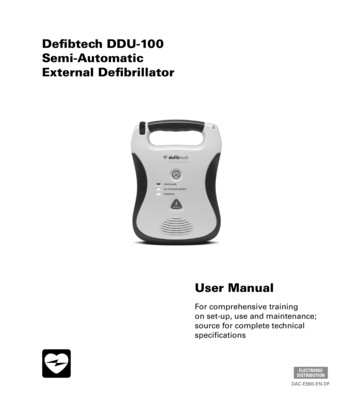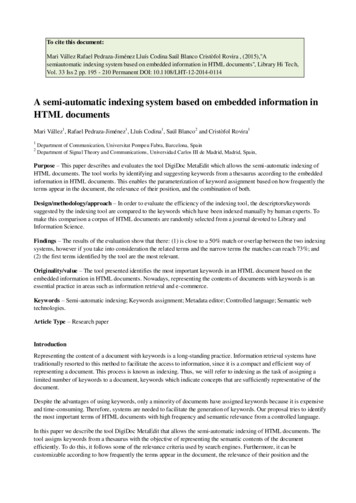
Transcription
To cite this document:Mari Vállez Rafael Pedraza-Jiménez Lluís Codina Saúl Blanco Cristòfol Rovira , (2015),"Asemiautomatic indexing system based on embedded information in HTML documents", Library Hi Tech,Vol. 33 Iss 2 pp. 195 - 210 Permanent DOI: 10.1108/LHT-12-2014-0114A semi-automatic indexing system based on embedded information inHTML documentsMari Vállez1, Rafael Pedraza-Jiménez1 , Lluís Codina1, Saúl Blanco 2 and Cristòfol Rovira112Department of Communication, Universitat Pompeu Fabra, Barcelona, SpainDepartment of Signal Theory and Communications, Universidad Carlos III de Madrid, Madrid, Spain,Purpose – This paper describes and evaluates the tool DigiDoc MetaEdit which allows the semi-automatic indexing ofHTML documents. The tool works by identifying and suggesting keywords from a thesaurus according to the embeddedinformation in HTML documents. This enables the parameterization of keyword assignment based on how frequently theterms appear in the document, the relevance of their position, and the combination of both.Design/methodology/approach – In order to evaluate the efficiency of the indexing tool, the descriptors/keywordssuggested by the indexing tool are compared to the keywords which have been indexed manually by human experts. Tomake this comparison a corpus of HTML documents are randomly selected from a journal devoted to Library andInformation Science.Findings – The results of the evaluation show that there: (1) is close to a 50% match or overlap between the two indexingsystems, however if you take into consideration the related terms and the narrow terms the matches can reach 73%; and(2) the first terms identified by the tool are the most relevant.Originality/value – The tool presented identifies the most important keywords in an HTML document based on theembedded information in HTML documents. Nowadays, representing the contents of documents with keywords is anessential practice in areas such as information retrieval and e-commerce.Keywords – Semi-automatic indexing; Keywords assignment; Metadata editor; Controlled language; Semantic webtechnologies.Article Type – Research paperIntroductionRepresenting the content of a document with keywords is a long-standing practice. Information retrieval systems havetraditionally resorted to this method to facilitate the access to information, since it is a compact and efficient way ofrepresenting a document. This process is known as indexing. Thus, we will refer to indexing as the task of assigning alimited number of keywords to a document, keywords which indicate concepts that are sufficiently representative of thedocument.Despite the advantages of using keywords, only a minority of documents have assigned keywords because it is expensiveand time-consuming. Therefore, systems are needed to facilitate the generation of keywords. Our proposal tries to identifythe most important terms of HTML documents with high frequency and semantic relevance from a controlled language.In this paper we describe the tool DigiDoc MetaEdit that allows the semi-automatic indexing of HTML documents. Thetool assigns keywords from a thesaurus with the objective of representing the semantic contents of the documentefficiently. To do this, it follows some of the relevance criteria used by search engines. Furthermore, it can becustomizable according to how frequently the terms appear in the document, the relevance of their position and the
combination of both. In order to evaluate the efficiency of the indexing system, we compare the descriptors suggested bythe tool to those used in a portal of electronic journals by human experts.The article is organised into the following sections: first, a brief overview of the literature related to indexing andautomatic indexing; second, the research objectives; third, the presentation of the tool DigiDoc MetaEdit to assignkeywords to HTML documents; fourth, the methodology section with information about the experimental datasets, theconfiguration of the tool, and the evaluation process; fifth, the results obtained in the evaluation and the analysis of them;and finally, the conclusions and future lines of research.Literature reviewIndexing theory attempts to identify the most effective indexing process, for indexing to be executed as a science ratherthan as an art (Borko, 1977; Hjørland, 2011). In the academic literature, indexing process involves two main steps: one,identifying the subjects of the document, and two, representing them in a controlled language (Mai, 2001). This process isalso known as subject indexing, in which the representation of the documents is conditioned by the controlled languagestructure. Some authors, Lancaster (2003) and Mai (1997) among them, analyze this procedure and the problems ofidentifying subjects. Others, such as Willis & Losee (2013) or Anderson (2001a, 2001b), review the most importantaspects of manual and automatic subject indexing and also the differences between both systems.Manual indexing involves an intellectual process using a controlled language, which results in this system being difficult,slow and expensive. It also entails a high number of inconsistencies, both external, when the task is conducted bymultiple indexers, and internal, when a single indexer performs the work at different times (Olson and Wolfram, 2008;White et al., 2013; Zunde and Dexter, 1969) .Moreover, automatic indexing can be approached from two main perspectives. The first one is keyword extraction, basedon the keyword’s appearance in the text and in the whole of a collection (Frank et al., 1999; Zhang, 2008; Beliga, 2014).The second technique is keyword assignment, based on the matching of terms between the text and a thesaurus (or someother controlled vocabulary) (Moens, 2002; Yang et al., 2014) .The different approaches for the first technique —keyword extraction— can be grouped into three categories: systemsbased on machine learning; systems based on rules for patterns and systems supported by statistical criteria (Ercan andCicekli, 2007; Giarlo, 2005; Kaur and Gupta, 2010). These different approaches can also be combined.Firstly, machine learning systems rely heavily on probabilistic calculations from training collections (Abulaish andAnwar, 2012). They adapt well to different environments, but their drawbacks should also be mentioned: they requiremany examples, it is difficult to select appropriate sources for training, they consume considerable time before qualityresults appear, and their performance degrades when the heterogeneity of documents increases.Secondly, systems based on rules for patterns depend on the experience of the person who develops them, thereforerequiring specialists to define the extraction rules for each domain. This definition process might also include linguisticcriteria in order to select the keywords (Hulth, 2003; Hu and Wu, 2006) and, as such, it involves morphological, syntacticand semantic analyses to perform the disambiguation process. These systems are complex and require devoting time tothe configuration; also, it is difficult to introduce changes to them.Finally, systems based on statistical criteria (Ganapathi Raju et al., 2011; Matsuo and Ishizuka, 2004) do not require atraining phase, although in many cases they require big corpora in order to perform the calculations. Some statisticalmethods used are: word frequency, TF-IDF, mutual information, co-occurence, etc.The approach to the second technique —keywords assigned from a thesaurus— has also been tackled from variousperspectives (Gazendam et al., 2010). The following are examples of this kind of approach: Kamps’ proposal (2004)resorts to a thesaurus and establishes a strategy for reordering keywords obtained through semantic relations. Likewise,Medelyan & Witten (2006a) resort to the semantic relations from a thesaurus to optimize the results obtained withmachine learning techniques. Lastly, Evans et al. (1991) suggest combining natural language processing techniques withthe information provided by a thesaurus. This approach is very common in areas with high scientific knowledge
production and indexing is important, such as in biosciences, medicine or aeronautics (Glier et al., 2013; Névéol et al.,2009).Thus, it can be observed that both the extraction and assignment of keywords are commonly present in hybrid systemscombining the two methods (Hulth, 2004).In any case, both models present disadvantages. Keyword extraction might present wrong results, particularly regardingwords formed by several terms (that is to say, when the systems used have to identify n-grams). Regarding keywordassignment, the main problem is the difficulty of having controlled languages that cover the thematic diversity of thedocuments, as well as the constant need for updates, and both aspects are essential in contexts such as repositories anddigital libraries (Tejeda-Lorente et al., 2014).Research objectivesAutomatic indexing systems have been available for several decades (Sharp and Sen, 2013; Spärck Jones, 1974). Theseallow you to process a lot of information quickly and cheaply, and also ensure the inter-indexer consistency. Howeverautomatic systems also present problems because of the complexity of natural language processing (Sinkkilä et al.,2011). Consequently the semi-automatic indexing approach is a good solution, because in addition to obviating theproblems of the automatic indexing system it facilitates the the task of indexers by providing suitable term suggestions(Vasuki and Cohen, 2010).In this context, the main goal of this research is evaluating the results obtained with DigiDoc MetaEdit, a web-accessibletool, that allows semi-automatic indexing based on the embedded information in HTML documents. The tool identifiesthe highlighted terms of HTML documents and assigns descriptors from a specialized thesaurus.The specific objectives to reach this goal are: first, analyzing the results obtained with the different configurations of thetool to carry out the indexing; second, comparing the indexing proposed by the tool with the indexing carried out byprofessional indexers; third, identifying the descriptors incorrectly assigned by the tool; and finally, demonstrating theviability of the proposal with the results.DigiDoc MetaEditDigiDoc MetaEdit is a metadata editor (Pedraza-Jiménez et al., 2008, Vállez et al., 2010) that allows the description ofthe content of HTML pages. The tool was created with the mission to help metadata assignment, focused in particular onidentifying the keywords for the purpose of indexing. Describing contents with metadata aids development andoptimization of internal search systems, such as search engines for digital repositories, intranets or corporate websites,where improved search tools are essential. It is worth noting that Semantic Web Case Studies from W3C show thatimproved search is, in terms of frequency, the second most popular application of semantic web technologies (“Improvedsearch - Semantic Web Case Studies and Use Cases” n.d.). First place was taken by data integration.The DigiDoc MetaEdit has an interface that lets users set the selection criteria for keywords assignment. Keywords arethen proposed using a specialized controlled language, a thesaurus, to recommend synonyms, narrower terms, broaderterms, and related terms to the words appearing in the document analysed. Once the keywords have been extracted, thetool produces an RDF file with the metadata and a report with the keywords scored.DigiDoc MetaEdit has been developed as a free software application with a GLP licence. It is a dynamic applicationdesigned in Perl using MySQL for data storage. Its structure is modular, which makes it easier to add new features. Thethree main modules are: Customization module: its aim is to enable the customization of the tool in terms of the controlled language, themetaformats and the weight assignment to identify keywords. Extraction module: its aim is to extract the keywords and metaelements from the HTML documents. Output module: its aim is to present the extracted meta elements and to generate fragments of code with themetadata adapted to several standards, such as RDF or Dublin Core.
Figure 1 shows a summary of how DigiDoc MetaEdit is structured:Figure 1. Components of the DigiDoc MetaEdit tool.The tool contains the following components:1. Data input interface: allows the user to indicate the URL of the HTML document or set of documents to beanalysed.2. Thesaurus: is the controlled language used to extract the keywords of the document.3. Keyword weighting software: the tool presents mechanisms allowing the user the configuration of criteria andvalues for automatic keyword extraction, even though it already has a default configuration. The criteria which canbe configured are based on some aspects considered in search engine optimization algorithms, such as: term frequency: the number of times the term appears in the text, location of the term (semantic markup): title, headers (h1, h2), URLs, anchors, emphasis, strong.4. Text processing software: allows for the analysis of the textual contents of an HMTL document, and the extractionof its most significant keywords from the defined relevance criteria and the thesaurus.5. Output interface: suggests formalized keywords as metadata of the document, in formats such as Dublin Coremicroformat, RDF and XHTML.During the last years researchers and developpers from the Semantic Web and Linked Open Data community have madesemantic tools for automatically editing and annotating web content. By example the applications developed by theDbpedia community (http://wiki.dbpedia.org/Applications). Thereby, different platforms offer semantic annotation(Bukhari et al., 2013; Golbeck et al., 2002; Hu and Du, 2013), although in most cases they require complex infrastructurebecause they are part of a framework. In addition, there are a range of tools that offer similar solutions related to keywordresearch (Vállez, 2011), but most of them are based exclusively on statistical techniques to provide the proposedkeywords, without taking into account the content structure and specific domain. Likewise, DigiDoc MetaEdit offers arange of different features from a single platform this is where our work breaks new ground.
MethodologyIn order to evaluate the efficiency of the indexing proposal with the DigiDoc MetaEdit tool, this paper presents acomparison of the descriptors suggested by the system and those used by indexers in Temaria (http://temaria.net/), aportal of electronic journals on Library and Information Science. Regarding the present evaluation, we considered that thedescriptors assigned by indexers were better to describe these documents. However sometimes the selection of adescriptor can be subjective (Coffman and Weaver, 2014; El-Haj et al., 2013).Experimental data setsThe corpus selected to conduct this evaluation consisted of a random selection of 100 articles, in HTML format and inSpanish, from BiD Textos Universitaris de Biblioteconomia i Documentación (http://bid.ub.edu/), a journal specialized inLibrary and Information Science indexed on the portal Temaria. This portal indexes articles from Spanish journalsdevoted to Library and Information Science and can be accessed online. It currently includes articles published in 14Spanish journals.The articles were indexed with descriptors from the Tesauro de Biblioteconomía y Documentación (Thesaurus on Libraryand Information Science), a controlled language developed by the Spanish Instituto de Estudios Documentales sobreCiencia y Tecnología (IEDCYT) (Monchon and Sorli, 2002). Table I shows a summary of the elements and relationsestablished in the thesaurus.Table I.Elements of the thesaurusNumber of conceptsNumber of non preferred termsNumber of broader termsNumber of narrower termsNumber of related terms1,0975691,0881,0722,354The number of descriptors assigned to each article ranges between two and eight, with 4.14 descriptors on average and astandard deviation of 1.37. Taking this information as a starting point is contrasted to the descriptors assigned to eachdocument with the 5, 10 and 15 keywords obtained with the DigiDoc MetaEdit. This checks that the first keywordsascribed are the most appropriate.Configuration of the toolThe tool can be configured to decide which aspects to assess when HTML documents are processed to assign keywords.The Keyword weighting software lets you define settings to test different results. The configuration of the system hasbeen conducted in different stages. In the beginning eleven parameterizations were defined that were subsequentlygrouped and delimited under three parameterizations: Frequency: based on the number of times a term appeared in the document.Semantics: based on the position of the term in the document according to embedded HTML information. Thisparameterization considers the location of the keywords in the HTML document, such as in the title of the page,in the metadata, in the headers, in the typographic emphasis (bold type or italic), in the alternative text of theimages or links, and so on. This measure was determined by the semantic relevance of the word, hence the name.Mixed (Frequency and Semantics): the importance of the keywords was pondered by combining aspects of thetwo previously mentioned parameterizations, in so doing it attempts to find a balance between the frequency andthe position occupied by the word in the document.DigiDoc MetaEdit included the same thesaurus used by human indexers to compare the results obtained with the indexingtool.
Evaluation processIn order to test the robustness of the tool an evaluation system has been designed (shown in Figure 2). To do so, we firstselect a corpus of documents manually indexed using a thesaurus. Second, the metaeditor processes this corpus, andautomatically suggests descriptors for each document. The output has three different indexing proposals for eachdocument. Then, the descriptors assigned by indexers are compared to the descriptors suggested by each one of theparameterizations. An exact overlap is required. Next, the best parameterization is that which identifies a higher numberof overlapping descriptors that proposed by human indexers. Finally, two indexers analyses whether the keywordsassigned to each document are correct.Figure 2. Evaluation process of the tool.A number of routines have been written in Python to process and run comparisons of the settings. These routines processthe files, identify the matching words and present the results. The coding in Python used object-oriented programming toaid replication of the experiment with other data sets and settings. The open source code can be found on the Gitrepository at: https://github.com/beauseant/MITAD.The measures for evaluating the results offered by the tool have been those habitually used to assess automatic indexing(Medelyan and Witten, 2005; Verberne et al., 2014) as defined in Eq. (1-3):(1)(2)(3)The “# correct assigned keywords” value corresponded to the number of correctly assigned keywords in an automaticway. They were considered to be correctly assigned when the automatically identified descriptors match the descriptorssuggested by human experts. The “# assigned keywords” value was the total amount of keywords describing a document;
that was to say, the amount of descriptors assigned by a human expert to the document. Lastly, “# manually assignedkeywords” was the total amount of automatically suggested keywords.Thus and as previously mentioned, it was possible to estimate both the percentage of automatically assigned keywordsbeing relevant (precision) and the percentage of matches to the manually assigned keywords (recall). Since both measuresact inversely (Cleverdon, 1972), the F-measure was used as a balanced combination of the two previous ones (VanRijsbergen, 1977), allowing for the harmonious average of precision and recall.Results and analysisFirst, we compared the two indexing systems, manual and automatic. Then we evaluated the results in the automaticindexing system for the three parameterizations. The next step was to study how the assigned descriptors in both indexingprocesses were distributed and characterized. And lastly, we analysed the quality of the descriptors automaticallyassigned by DigiDoc MetaEdit.Table II shows the keywords in common to both systems, and at the same time presents different semantic relationsidentified between words. The coincidental terms are identified in bold type in both indexing processes. The terms afterthe signs “ ” correspond to broader terms among those suggested in the manual indexing, and those headed by “**” tothe related terms. This information is extracted from the semantic relations appearing in the thesaurus.Table II.Comparative process of keywords assigned to a document (translated to English for the reader’s convenience)Title: Cooperative repositories of the Digital Library of CataloniaCut off: 5/10/15 termsAutomatic indexingManual indexingFrequencySemanticsMixedDig ital librariesDissertationsOpen archi vesDissertationsLibraries consortiums Software Software SoftwareCopyrightsAcademic journalsDissertationsAcademic journalsOpen archi vesMetadataAuthority controlMetadataFree software Libraries** Co mputer programmes** Co mputer programmesUniversity centresAcademic libraries Libraries** Co mputer programmesCopyrightsUniversity centresVisib ility** Electronic resourcesOpen archi vesFree softwaree-GovernmentFree softwareDig itizationLibrary managementVisib ilityAuthorshipAcademic journalsDig itizationInteroperabilitySpecial collectionsAcademic librariesAcademic librariesInformation SocietyAcademic co mmun ityAcademic co mmun ityElectronic journalsAuthors indexJournal articlesElectronic journalsAuthorshipNote: Bold type the coincidental terms identified in both indexing processes.“ ” broader terms of Manual indexing assigned.“**” related terms of Manual indexing assigned.This example shows that the two indexing systems overlap, particularly when a cut off of ten terms is applied, as alsoshown in the Table IV. Thereby Mixed parameterization with ten terms cut off offers the best results and is used as abasis for following comparisons.
It is also important to emphasize that there is a high number of documents sharing descriptors in both indexing systems.Thus, 92 % of the documents match in both systems, meaning that 92 documents on average share almost two descriptorsin both indexing systems. Therefore both systems offer similar results.The second stage of the comparison process took into consideration the semantic relationship between the first tenkeywords suggested by the metaeditor under the Mixed parameterization, with those assigned by the human indexers. Inthis case, the broader terms and related terms of the descriptors assigned by indexers were taken into account to calculatethe exact overlap (Medelyan and Witten, 2006b). Table III shows how, by considering these semantic relations from thethesaurus, the automatic indexing increased recall. Thus, it shows that there is a semantic relation between the keywordsused in both kinds of indexing. Although there is not an exact match, keywords assigned with the DigiDoc MetaEdit toolmaintain a strong link with those used by indexers.Table III.Recall considering the relations of the thesaurusRecallNote:MixedMixed NTMixed RTMixed (NT RT)0.490.580.640.73NT narro wer termsRT related termsOf the two semantic relations studied (narrower terms and related terms), recall showed the greatest increase –of 15 %–with the one including related terms. This kind of relationship allowed for the identification of keywords that did notpresent a “parent-child” relationship, a fact which contributed to obtaining terms with a higher semantic variety. Thispoint is interesting because search engines take into account the variety of terms instead of just the frequency of a term.Nevertheless, if the narrower terms were included, the increase amounted to only 9 %. Also significant in this case wasthe fact that most of the terms included mainly referred to the concept Libraries. This fact shows that narrower terms donot contribute semantic variety to the indexing system or help identify further meaningful keywords.Table IV below shows the averages of the evaluation measures used (recall, precision and F-measure) for the threeparameterizations.Table IV.Average number of matches in each parameterization with manual indexingRecallPrecisionF-measureCut n order to check the evolution of recall with regard to the number of keywords suggested by the metaeditor, additionalintervals for analysis were created. Figure 3 shows how recall evolved under Mixed parameterization, with an increase inthe number of keywords suggested by the automatic system: as more descriptors were considered, the increase in recallwas gradually diminished. Thus, the ordering of the descriptors suggested by the metaeditor was working: the first termsidentified by the tool were the most relevant, since they entailed a higher increase in recall.
Figure 3. Recall increases for Mixed parameterization.Regarding the distribution of keywords used in the corpus of documents, 168 of the 414 keywords used by the indexerswere unique. Therefore the corpus of documents maintain a strong relationship among themselves. However, the Mixedparameterization with ten terms cut off provides 90 keywords unique from the 195 descriptors overlapped with thoseassigned by the human experts. On the basis of the calculations made with this data, automatic indexing offers moresemantic variety.Furthermore, similarly to what happens with natural language, and as stated by Zipf’s law, in manual and automaticindexing many words presented a low frequency of use (long tail), whereas a few concentrated a high frequency. Thisinformation was significant since a good description must be characterized by its level of specificity. The high number ofdescriptors in the thesaurus that were seldom assigned is proof of that.To study this aspect, it is interesting to see the distribution of keywords assigned according to their frequency (Figure 4).The logarithmic scale of the following bar chart presents the frequency of the unique terms assigned.Figure 4. Frequency distribution of the keywords.The first row of the table accompanying the chart shows the frequency distribution of the 168 unique descriptors assignedby the human indexers to describe the corpus of documents. Thus, it can be seen that 90 descriptors were used only once,which means that 54 % of the terms were not repeated. The subsequent rows show the frequency distribution of the
assigned descriptors for each of the three parameterizations when these overlapped the manually assigned descriptors.Regarding the Mixed automatic assignment, 54 out of the 90 unique terms were used only once, which amounted to 60%of the terms. Thus, it was found that the metaeditor has practically the same or even slightly superior (6%) discriminatingability as the human expert when assigning keywords. This aspect is essential, since the specificity of the keywordscontributes to improving the process of information retrieval because it provides more precise results. Additionally, thegraph reveals that only three keywords were commonly used in the manual assignment, that is, they were employed morethan fifteen times. Their use was nonetheless reduced to one case in automatic indexing.Lastly, the quality of the terms provided by the metaeditor for Mixed parameterization was studied when ten descriptorswere suggested through the analysis of human experts. Two indexers analysed whether the keywords assigned to eachdocument with DigiDoc MetaEdit were relevant or not, as well as detecting the cases wherein it was a mistake to haveassigned a specific keyword. Table V shows the percentages obtained in each case for the corpus of documents.Table V.Adaptation of the terms in Mixed parameterization with ten terms cut offMixed – 10 terms cut offExact Terms (Precision)Relevant TermsNot relevant TermsWrong Terms20%69%4%7%The exact terms match up in both indexing systems; the relevant ones are those that do not match up but clearly representthe contents of the document; the non relevant ones are those that, although appearing in the document, are notrepresentative enough of its contents. On the other hand, those terms considered ‘wrong’ are those that cannot be used todescribe the document because they are misleading. An example of this last case is the concept Bibliography, whichappeared frequently because every article had a section with this epigraph, therefore being suggested by the metaeditorwithout being representative of the documents. From a practical point of view, the keywords presenting problems are notsignificant.ConclusionsAfter conducting the different experiments, it is possible to conclude that the keyword assignment carried out by DigiDocMetaEdit offers positive results and is, therefore, an efficient system. The indexing proposed by DigiDoc MetaEditapproaches a 50% match rate with manual indexing when taking into account the Mixed parameterization with ten termscut off. Furthermore, it reaches 73% when related terms and narrower terms are considered. Besides, according to expertassessment, 89% of the words have been correctly assigned, with only 7% of misallocations and 4% of non-relevantassignments.Nowadays in a situation of information overload, the identification of the most significant keywords in a document canserve various purposes. To a great extent, they can be focused on synthesizing the content of a document to facilitateaccess to it. The exponential increase of information brings about the need to automate
where improved search tools are essential. It is worth noting that Semantic Web Case Studies from W3C show that improved search is, in terms of frequency, the second most popular application of semantic web technologies ("Improved search - Semantic Web Case Studies and Use Cases" n.d.). First place was taken by data integration.
